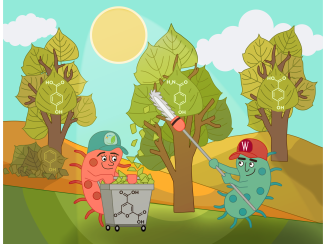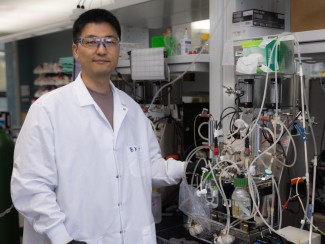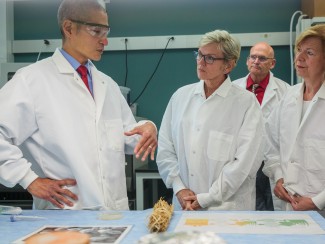
Momentum, it seems, might finally be on renewable energy’s side. The landmark global climate agreement signed by 196 countries in Paris this past December could help hasten a historic shift away from the use of fossil fuels and toward “clean” or low-carbon energy.
And yet how to make such a complex transformation is still the subject of contention, and ongoing research. For biofuels, in particular, the most pressing question is whether biomass-derived transportation fuels and chemicals can be developed in an environmentally and economically sustainable way, without creating competition between crops used for food and those used for fuel.
GLBRC discoveries are also cutting across diverse areas of research, with promising implications for industries at home and abroad, from biofuels to paper and pulping to organic farming.
That also happens to be the overarching challenge driving the more than 400 scientists, students and staff, including many Nelson Institute affiliates, at the Great Lakes Bioenergy Research Center (GLBRC). Led by the University of Wisconsin-Madison and major partner Michigan State University, GLBRC was created in 2007 by the U.S. Department of Energy. Its mission is to develop a sustainable pipeline for producing biofuels and chemicals from cellulosic, or non-edible, plant materials such as switchgrass and other grasses, poplar, and corn stover.
Some eight years later, what’s clear is that GLBRC’s multidisciplinary model of research – ecologists working with chemists, consulting with microbiologists, conferring with plant biologists – is yielding an unusually high number of technologies. GLBRC discoveries are also cutting across diverse areas of research, with promising implications for industries at home and abroad, from biofuels to paper and pulping to organic farming.
Since 2011, GLBRC scientists have reported inventions at a rate that exceeds expectations by more than 50 percent for a center its size, and have filed patent applications for 122 new technologies.
“What we’re seeing,” says GLBRC director and UW-Madison professor of bacteriology Tim Donohue, “is that collaborative partnerships greatly increase the potential for transformative research and technology transfer.”
A process called Zip-Lignin™ is one of those technologies. Zip-Lignin™ addresses one of the key obstacles for extracting sugars from biomass, a complex polymer called lignin. Lignin, the natural “glue” that gives plants their structural integrity and holds the sugars together, makes up about 30 percent of most biomass and is the most difficult part of the plant to break down. In a majority of paper and pulping mills, lignin is a waste product burned for process heat.
GLBRC researchers John Ralph and Curtis Wilkerson, along with Shawn Mansfield of the University of British Columbia, discovered that it was possible to introduce weak bonds (or “zips”) into the lignin polymer of poplar trees, making it much easier and cheaper to break apart. Zip-Lignin™ thus has tremendous potential to reduce the environmental and financial cost of deconstructing biomass, improving the bottom line of one of Wisconsin’s biggest industries, the paper, pulping and paperboard industry, and of cellulosic biofuel production.
Shannon Stahl, a GLBRC researcher and UW-Madison professor of chemistry, tackled the problem of lignin from another angle, developing a new way to convert it into high-value chemicals. Stahl and his team discovered an efficient, cost-effective method for breaking down lignin’s six-carbon rings – the “aromatics” – into individual components. Traditionally sourced from petroleum, aromatics are used in a wide variety of products, including plastic soda bottles, Kevlar, pesticides and pharmaceuticals, and are also essential components of jet fuel.
By converting what has been a large-volume waste product into a new source of renewable aromatics, Stahl’s technology stands not only to transform the economics of industries that process wood and other biomass into paper and paper products, but to also open the door to a more economical way of replacing petroleum-based fuels and chemicals with biorenewable materials.
Another GLBRC advance is taking on a different biofuels challenge: the expensive, energy-intensive, and sometimes-toxic chemical and biochemical processes used to break down biomass into liquid fuels. Using gamma-valerolactone (or GVL), a chemical that can be easily produced from plants, UW-Madison professor of chemical and biological engineering James Dumesic and his team discovered they could both deconstruct biomass and produce sugars that can be chemically or biologically upgraded into biofuels or chemicals. This one-step process is much cleaner and more affordable than conversion methods requiring expensive chemicals or enzymes, and could thus “green” a number of industries – biofuels and paper and pulp once again chief among them.
The center’s research has also given way to some unexpected findings. GLBRC scientist Jeff Piotrowski and collaborators from the University of Tokyo discovered a chemical compound that some day could be used as a fungicide in sustainable and conventional farming. Piotrowski uncovered the so-called “poacic acid” through research focused on the small molecule inhibitors present when cellulosic biomass is broken down for biofuel production.
Suspecting that these inhibitors’ strong anti-microbial properties meant they could also be valuable outside the context of biofuels, Piotrowski began screening a set of relatively little-known inhibitory compounds called diferulates for bioactivity against yeast. There he found poacic acid. After testing the compound against some common fungal pathogens and oomycetes (fungus-like microorganisms responsible for a host of plant diseases), he found that a single application substantially reduced pathogen growth.
Though field trials are underway, poacic acid may ultimately provide a natural fungicide option in a time when such options are not abundant, fungicide resistance is on the rise, and warming temperatures are increasingly causing fungal pathogens to spread northward. The discovery also underscores the complementary nature of twin pursuits: sustainable energy production and sustainable agriculture. Both areas stand to benefit from the increased importance of cellulosic biofuels in the economy.
Reflecting on the first seven years of GLBRC research, Donohue says, “It’s been eye-opening to see how GLBRC’s team approach has allowed us to make advances much faster than I ever imagined.” Still, Donohue acknowledges the research that’s needed to position biofuels as a sustainable, integral piece of a clean energy future.
“It’s exhilarating, but it’s also sobering,” he says.





